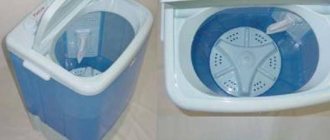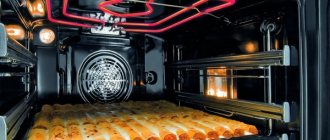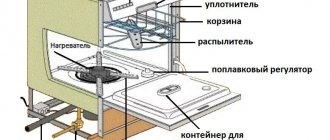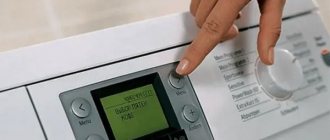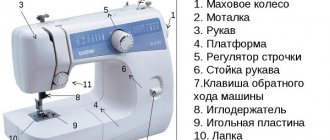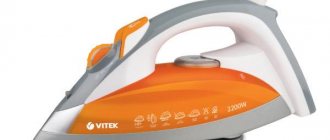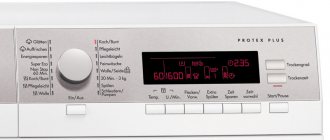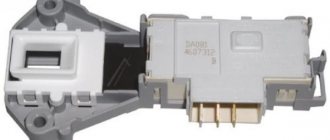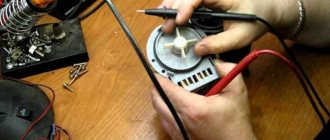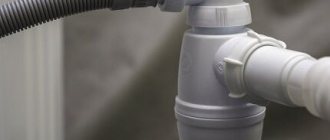How does a dryer work?
Structurally, the drying machine consists of several parts:
- chambers for things - usually in the form of a steel drum, in some models with backlight;
- an electric motor that drives the device and a belt drive connecting the motor to the tank;
- a heat exchanger consisting of two channels through which cold and hot air moves;
- heating element providing the desired flow temperature;
- a fan that picks up air masses and gives them the right direction;
- air intakes - they absorb dust and debris from clothing;
- containers for collecting condensate that forms during the drying process; the container is not provided in all models; exhaust hoods are not equipped with it.
On the outside of the housing of the household appliance there is a control panel with buttons for selecting the operating mode and an electronic display.
Important! Sometimes the design of a clothes dryer provides only direct rotation of the drum. But some models have a reverse function, which provides faster and better processing.
Who needs a dryer?
Many people are familiar with the problem of high-quality drying of clothes. High humidity, limited apartment space, and frequent washing make it difficult to care for things and textile accessories. You have to hang them in the house or on the balcony, and make sure that a sudden downpour does not disrupt your plans.
After this, clean items must be ironed, and this process also takes a lot of time and effort. A clothes dryer will help solve some of the problems, if not all. It will make life much easier if one of the following factors prevents you from using natural drying:
- Small apartment area. Owners of the unit will no longer have to lay out wet duvet covers and sheets in the house or hang them in the bathroom or on the balcony. Literally an hour of work and all textiles will be dried to an optimal condition, ensuring easy ironing.
- No balcony. Sometimes you come across amazing layouts of residential multi-storey buildings that do not have a balcony. A drying machine will save the owners of such apartments from the need to install a bulky dryer in the bedroom or kitchen.
- Frequent washing. Many housewives complain that the laundry does not have time to dry and because of this they have to postpone the next wash. A modern model will dry 3-8 kg of laundry in just an hour. A dryer will become an indispensable piece of equipment in large families.
Such a useful unit will allow you to forget forever about all the difficulties associated with drying clothes. Your favorite outfits and textile accessories will always be at hand.
Types of dryer
Any dryer works on the same principle: they process things with a stream of hot air, and thanks to this, moisture quickly evaporates from the fabric. But the implementation of this scheme varies depending on the model.
Drum dryers
Videos about the operation of clothes dryers show that in appearance and design, units of this type are similar to washing machines. Things are in a rotating drum, but they are not affected by water, but by hot air, which ensures the evaporation of moisture. Within a minute, the internal tank is capable of making more than a hundred revolutions, drying is fast and high-quality. The advantages of drum models include their compact size.
In the fast drying mode, it takes about 20 minutes to process items in the drum
Drying cabinets
In apartments and private houses, such units are rare - they are too large in size and represent a spacious and tall metal chamber. Drying things in a special cabinet occurs slowly. But the device is ideal for processing outerwear, shoes and fabrics for which mechanical stress is undesirable.
The drying cabinet does not wrinkle things and provides the most gentle treatment
Condensation
Dryers with a condensing operating principle are the most popular. As the name implies, the moisture evaporated from clothing settles in tiny particles inside a special reservoir. After completing the operating cycle, the water from the tray is simply drained and the filter is washed.
The condenser dryer can be placed anywhere in the house
Exhaust
These types of dryers are less popular. The moisture in them, along with the air flow, is removed into ventilation or into the environment - for example, out a window. Exhaust models are cheaper, but their installation is associated with certain difficulties; when positioning the unit, you need to think about where the massive hose will go.
Exhaust dryers take up more space and rarely fit into the interior
Washing machines with drying function
Conventionally, drying units also include washing machines with a built-in moisture evaporation mode. When this function is activated, after rinsing and spinning, the device heats the air using a heating element and supplies it to the empty drum. The main advantage of the units is obvious - there is no need to install two separate devices for washing and drying in the apartment.
The disadvantages of a washing machine with a built-in dryer are low power and high energy consumption
Advantages of a dryer
Housewives needlessly underestimate the device. It has a number of advantages:
- The laundry will dry regardless of weather conditions.
- Damp canvases are isolated from the room and will not increase air humidity. Accordingly, the risk of mold is reduced, wooden objects, electronics and books are not damaged, and the load on the lungs does not increase.
- The laundry dries in no time. This is convenient if the guest gets caught in the rain: he can go home in his clothes. A dryer is very useful in a family with small children: the necessary things are quickly returned from the wash.
- Damp laundry does not bother anyone, no one touches it, there is no risk that it will fall and get dirty or that someone in the household will trip over it.
- A loaded appliance takes up much less space than hanging lines or folding dryers. This is especially true if the family is large. There is no need to hang clean laundry around the apartment, yard and balcony, even if it is a general weekly wash.
- Linen that is dried on the balcony is exposed to exhaust gases, absorbs dust and foreign odors, including tobacco, if there are smokers in the house. When laundry hangs in the hallway, it is permeated by the smells of cooking, pets, and dust has time to settle on it. None of this happens in a dryer. Laundry stays fresh longer.
- Modern dryers provide a choice of modes for different types of textiles, and this guarantees careful handling of things.
- The device allows you to choose what level of humidity your clothes should have at the end. Therefore, clothes and linen will never be stiff from drying out or damp due to poor ventilation or cold.
- Dryers have a special anti-crease mode - it allows you to do without ironing.
The only disadvantages of the device are the high cost and the need for additional space in the house. Some models may make noise and require a water connection. But these disadvantages are not commensurate with the advantages of dryers. Their popularity is growing, and this is understandable: everyone wants to simplify the drying process and always have clean and fragrant laundry at hand.
Washing machine functions
Regardless of the principle of operation, clothes dryers usually support several operating modes:
- easy drying “under the iron”, in this case most of the water evaporates from the items, but they remain slightly damp, which is convenient for subsequent ironing;
- processing “in the closet” - after removal from the unit, clothes remain completely dry, they can be immediately put on or folded and stored;
- extra drying - takes the least time, but is usually used only for multi-layer fabrics that are resistant to high temperatures;
- delicate drying - processing of things occurs more slowly, but even the thinnest and most sensitive clothes can be loaded into the machine;
- “anti-crease” mode, after completion of the main operating cycle, the drum continues rhythmic rotation for several seconds until the door opens, the fabrics ultimately require almost no ironing;
- steam smoothing, when processing easily wrinkled laundry, the drying unit first sprays water inside the chamber, which then turns into steam and helps smooth out folds and creases on the clothes;
- ventilation, you can even load dry things into the machine that have been lying in the closet for too long, in which case the device will simply refresh them and remove dust, wool and unpleasant odors.
The more built-in modes a drying unit supports, the wider its functionality. Modern models process both delicate natural fabrics and jeans, outerwear and thick duvets.
How does a clothes dryer work?
There are two types of drying machines based on their design features. Their operating principles are different.
Drying cabinet
From the inside, the device looks like a regular wardrobe; it has shelves or hangers for clothes. When put into operation, a powerful heating element mounted in the floor or ceiling heats the air, and the fan distributes it evenly inside the chamber, creating a directed flow for drying things. At the end of the cycle, the moisture comes out through the ventilation hose or directly through the cabinet doors.
The drying cabinet must be ventilated after each use.
Drum type machines
Such devices also heat the air using a heating element, after which the fan directs it into a rotating drum. Passing through the fabric, the hot stream picks up moisture and falls to the heat exchanger, where it releases condensate and cools, and then returns to the heating element. In exhaust models, the air is immediately removed to the outside. In both cases, high-quality, uniform drying is ensured by rotating the drum.
The air circulating in drum machines warms up to 70 °C depending on the mode
How to use a clothes dryer
Since household appliances differ in design, be sure to read the documents for a specific model before using it for the first time. But the general operating instructions for the dryer will look like this:
- laundry is loaded into the unit, damp, but not excessively wet, but slightly wrung out after washing;
- close the camera of the device and select a mode in accordance with the desired degree of drying and type of fabric;
- press the start button and wait until the machine completes the cycle;
- The laundry is removed from the chamber and sent to the closet or for ironing, depending on the selected degree of humidity.
After each use of the dryer, it is recommended to carry out basic maintenance of the unit. First of all, it is necessary to immediately remove debris from the fluff filters, which collect dust, pet hair, hairs and small threads. These elements become clogged very quickly, which immediately affects the quality of drying.
After the drying cycle, the unit must be left open for at least half an hour.
If the machine operates on the condensation principle, you must also remove the special tray and drain the water from it, even if it is not yet completely filled. The empty container is rinsed under the tap and placed in place.
Advice! If you need to process a large batch of laundry, it is better to put a new batch of clothes in the dryer after an hour break. This will extend the life of the unit.
How to choose a dryer
If it is decided that after purchasing such equipment, the everyday side of life will be easier, you need to move on to selecting a model. And in order to make the right choice, you need to understand what characteristics affect the quality of drying and ease of use.
First of all, you need to decide on the type of equipment: cabinet or drum. You can also purchase a washing machine with a drying function, but it will cope with moisture evaporation worse. Then you can move on to a more detailed assessment.
